#alchemy has 3 principles: Salt -> Mercury-> Sulphur
Explore tagged Tumblr posts
Text
Even worse. I thought about him some more and he's probably a noble's illegitimate son. So his actual name isn't anything fancy. It's just. Clay.
I imagine by 3rd stratum he'd tell Kenji and Hai and they'd squint and go. "Ough.... Why don't we keep calling you Aer?"
Back at it again with giving my guild members silly names.
Ragna lore: for some reason I never select landsknechts for my guild. I can't really say why. I just dont use them and favor the gimmick classes.
But there's always a quest requiring a lvl xyz landy WJSJSJ Eo2 I picked one. Named him "Aer".
Aer sounds like Air. WHICH SOUNDS LIKE HEIR.
So just now decided he's some noble and he goes "I'm HEIR!!" Angrily before realizing he's not supposed to say that and claims that "Yeah uhmm... that's my name HAHAHAH. I'm Aer. " *Sweats profusely*
#ragna ramblings#i accidentally made a theme with the guild's names#except Kenji#the theme is around alchemy#alchemy has 3 principles: Salt -> Mercury-> Sulphur#each principle has elemental aspects#Salt -> Earth and Water#Mercury -> Water and Air#Sulphur -> Air and Fire#Cinnabar is a form of Mercury. Seen as an inbetween between salt and sulfur. just like cin is the middleman of the guild#Gabieta is a fire related name fire's considered the most holy/spiritual element. Also the motivation for alchemists. (CINNABAR's MOTIVE)#Aer sounds like Air. But his actually name Clay is a form of earth#he's got air and earth duality#Hai's name means ocean -> water#Salt is the earthly principle since its the only one with Earth snd Sulphur is the spiritual element since its the only one with fire
9 notes
·
View notes
Text
What's up with the OIAR?
Disclaimer/spoiler warning: Written after TMAGP ep. 34. Spoilers for all of the Magnus Protocol until this point. Minor spoilers for the Magnus Archives.
These are some theories I've cooked up in the alchemy lab of my mind. They are wild, incomplete and probably contradictory, so take them for what they are. I base all of this on the tria prima theory I explained in an earlier post, so go read that for context.
I decided to only focus on the OIAR in this post. I'll make another post on my Magnus Institute theories later and link to them eventually.
What's the purpose of the OIAR?
Here's what we know:
The OIAR monitors and assesses incidents and (at least in the past) responds to them if necessary
Based on the ARG and Colin's ramblings, it used to be under DDR, probably run by their secret police. Fr3-d1's source code is in German, so that makes sense. The operation was probably moved to the UK after the DDR disbanded.
It employs and (according to Lena) manages "externals". Lena considers this work vital, and Colin blames the OIAR for only caring about the "balance", specifically mentioning mercury and sulphur.
I will start by quoting the German physician and alchemist Paracelsus who first proposed the tria prima as the integral principles and used them in his practice of medicine.
If you have a bone and can say whether it is mostly Sulphur, Mercury, or Salt, you know why it is diseased or what is the matter with it. The peasant can see the externals, but the physician's task is to see the inner and secret matter. (Paracelsus, Opus Paramirum)
(Translation by Nicholas Goodrick-Clarke. I compared it against another translation and the original German, and it's more or less accurate but much easier to understand.)
This may sound far-fetched, but I think the OIAR are practicing Paracelsian medicine on a macrocosmic level. That is, they are monitoring the universal levels of Sulphur, Mercury, and Salt, the imbalance of which is causing these weird supernatural occurrences. Except they can't address every incident individually, so they can only concern themselves with the overall effect (surely a mercury poisoning somewhere balances a salt poisoning somewhere else) and only step in if there is a universal excess of one principle over others. At that point they arrange for their carefully curated externals to go out and do whatever they do to spread their diseased influence. (As an interesting side note, Paracelsus also likes to use the word external (das Eussere), although he mostly uses it to denote the macrocosmos (the nature/universe) which is reflected in the microcosmos (ie. the human body). Occasionally, like in the quote above, he uses it in the sense of "the human body as viewed from the outside".)
If this is the case, then the OIAR employees would function kind of like diagnosticians who assess the nature and severity of the incidents. I also imagine the responses used to be a bit more aggressive until the response unit mysteriously ceased to be. Could have something to do with their associates at Starkwell burning down the Magnus Institute right before they were about to undertake their Magnum Opus (more on that in a later post). A good call, but probably bad for optics. I also think it's a very bad sign that there is currently no one in charge who knows what their actual purpose is.
What's up with Fr3-d1?
I have tried and tried to figure out Fredi's classification system (or as I now see it, the diagnosis), to no avail. I'm fairly certain that the category CAT simply denotes whether the case concerns 1. an individual/living creature, 2. a location or 3. an object or non-living creature. I imagine the rank has to do with the severity or urgency of addressing it. But the DPHW eludes me. I somehow want to link it to the elemental properties (dry, cold, hot, wet) that (according to Paracelsus) are the usual cause for changes in the principles, but the acronym doesn't mesh. I can't help but feel that the answer is somewhere in Paracelsus's writings, as he appropriately wrote in German and could easily provide direct equivalents in TSHU. Or I could be wasting my time and it's something entirely unrelated. I definitely shouldn't go any deeper into that particular rabbit hole. And yet...
I do think that Fredi was originally just a soulless machine created for a purpose, but it's recently been possessed by a consciousness (anima). Unfortunately, I'm not quite ready to buy the John/Martin/Jonah theory, because it feels too much like a red herring. They gave it to us very early on, so clearly that's a conclusion they wanted us to jump to. No mystery writer does that unless it's for misdirection. Though I could potentially buy a version where they ended up in there in mind (mercury) alone. If you read my previous post (and this probably didn't make much sense unless you did), I explained that the mercurial qualities and associations are reminiscent of the Eye, especially the associations to thought, knowledge, universal essence of existence, the fluctuating boundary between corprorality and non-corporality, and the idea of connecting heaven and earth (and possibly other worlds?). What I'm saying is, the three of them, in the eye of the panopticon, were already in a pretty mercurial state. So while I'm not banking on it, I'm also not saying it's impossible.
Whatever the case, I think we can all agree that Fredi (or whoever's in there) is manipulating everyone to their own goals.
#the magnus protocol#tmagp#tmagp spoilers#tmagp theory#tmagp tria prima theory#oiar#magnussing#guys i'm going insane#i'm in full research mode that I SHOULD direct at my master's thesis#hyperfixation go brrr
33 notes
·
View notes
Text
Alchemy: sulphur, mercury, and salt
In alchemy, the three basic substances—sulphur, mercury, and salt—serve as fundamental principles that symbolize aspects of the cosmos and the human experience. Each has deep symbolic and spiritual significance:
1. Sulphur (The Active Principle)
Elemental Association: Fire
Symbolizes: The soul, the essence of individuality, and the principle of combustion or activity.
Role in Alchemy: Sulphur is considered the "masculine" principle. It represents the fiery, volatile, and transformative energy that drives change.
Spiritual Meaning: It embodies passion, will, and the spiritual drive to transcend the mundane.
2. Mercury (The Mediating Principle)
Elemental Association: Water and Air
Symbolizes: The mind, intuition, and adaptability. Mercury is volatile and elusive, embodying the spirit or life force.
Role in Alchemy: Mercury is the "feminine" principle and serves as the bridge between opposites, such as body and soul or matter and spirit.
Spiritual Meaning: It represents fluidity, transformation, and the process of enlightenment. The "mercurial serpent" often symbolizes the dynamic force of change and evolution.
3. Salt (The Fixed Principle)
Elemental Association: Earth
Symbolizes: The body, physicality, and stability. Salt is the "fixed" principle that grounds and crystallizes the other two forces.
Role in Alchemy: Salt provides structure and permanence, acting as the container for sulphur and mercury to interact and transform.
Spiritual Meaning: It represents endurance, preservation, and the foundation of existence.
The Alchemical Process
The goal of alchemy is to harmonize these three principles through a series of processes that purify and elevate matter and spirit. This often involves the creation of the Philosopher’s Stone, a symbol of perfection, enlightenment, and unity.
Key stages of the alchemical process include:
Calcination: Breaking down the material (symbolically burning away the ego).
Dissolution: Dissolving impurities and releasing the true essence.
Separation: Distinguishing the pure from the impure.
Conjunction: Combining opposites (sulphur, mercury, salt) to form a harmonious whole.
Fermentation, Distillation, and Coagulation: Further refining to achieve spiritual and material perfection
Biblical Verses with Alchemical Insights on Salt
Matthew 5:13
"You are the salt of the earth; but if the salt loses its flavor, how shall it be seasoned?"
Alchemical Insight: Salt represents the fixed principle, the body, and stability. This verse calls believers to embody purity and integrity, much like salt preserves and stabilizes. Losing one's "saltiness" parallels losing spiritual essence, purpose, or the groundedness of one’s divine nature.
Mark 9:50
"Salt is good, but if the salt loses its flavor, how will you season it? Have salt in yourselves, and have peace with one another."
Alchemical Insight: Salt’s alchemical role as the physical manifestation (body) emphasizes the need to maintain inner balance. "Having salt in yourselves" suggests being grounded in one’s spiritual and physical essence to create harmony and peace.
Colossians 4:6
"Let your speech always be with grace, seasoned with salt, that you may know how you ought to answer each one."
Alchemical Insight: Just as salt is the medium that holds and preserves, speech seasoned with salt symbolizes grounded wisdom and truth. Salt’s alchemical quality reflects the importance of clarity and substance in communication.
Leviticus 2:13
"With all your offerings you shall offer salt."
Alchemical Insight: Salt, as a stabilizer and purifier, represents the sacred link between spirit and matter. Offering salt signifies the integration of divine will into the material world, much like alchemy transforms the mundane into the sacred.
2 Kings 2:20-21
"Bring me a new bowl, and put salt in it...Thus says the Lord: I have healed this water; from it there shall be no more death or barrenness."
Alchemical Insight: This act reflects the purifying and preserving powers of salt. In alchemy, salt symbolizes the power to transmute impurities into life-giving forces. Healing the water with salt is analogous to the alchemical purification and rejuvenation of matter.
Alchemy and the Triad of Principles
In alchemy, salt is one of the three prime substances:
Salt (Body): Fixity, crystallization, and material foundation.
Sulphur (Soul): Combustibility, spirit, and passion.
Mercury (Mind): Volatility, adaptability, and connection between body and spirit.
In biblical terms, salt often plays the role of stabilizing the covenant between humanity and God, much like it stabilizes the spiritual process in alchemy.
Synthesis of Alchemy and Scripture
The Bible’s frequent mention of salt as a purifier, preserver, and covenantal symbol parallels alchemy’s view of salt as the physical embodiment of divine principles. It underscores the idea of maintaining balance and grounding while striving for spiritual transformation and renewal.
Qur'anic Verses Referencing Salt and Alchemical Interpretation
Surah Al-Furqan (25:53)
"And it is He who has released [simultaneously] the two seas, one fresh and sweet and one salty and bitter, and He placed between them a barrier and prohibiting partition."
Alchemical Insight: The two seas represent duality—a central theme in alchemy. The salty and sweet waters symbolize opposites: the fixed (salt) and the volatile (mercury). The barrier represents the balancing force required to harmonize and transform these opposites, leading to spiritual perfection.
Surah Fatir (35:12)
"And not alike are the two bodies of water. One is fresh and sweet, palatable for drinking, and one is salty and bitter. And from each you eat tender meat and extract ornaments which you wear."
Alchemical Insight: Salt's role as a purifier and preserver connects to the fixed principle of alchemy, which provides stability and allows for the extraction of spiritual "ornaments" or truths from the physical world. The verse highlights how both sweet and salty waters have their purpose, just as the alchemical triad of sulphur, mercury, and salt work together for transformation.
Surah An-Nahl (16:14)
"And it is He who subjected the sea for you to eat from it tender meat and to extract from it ornaments which you wear. And you see the ships plowing through it, and He subjected it that you may seek of His bounty and perhaps you will be grateful."
Alchemical Insight: The sea (often salty) symbolizes the prima materia in alchemy—raw material to be transformed. Salt is derived from the sea, serving as the crystallized form of divine essence. This verse reflects how physical and spiritual bounty emerges through divine will and balance.
Alchemical Concept of Salt in the Qur'anic Context
In alchemy, salt is the principle of fixation and materiality, representing the body and the physical manifestation of spiritual truths. Here's how the Qur'anic references to salt align with alchemical ideas:
Salt as Purification
Salt purifies and preserves, a quality often associated with divine wisdom and creation in the Qur'an.
In alchemy, salt represents the purified essence of the material world, acting as the foundation for spiritual transformation.
Salt as Balance
The Qur'an’s mention of the balance between fresh and salty water reflects the alchemical need to harmonize opposites (e.g., body and spirit, fixed and volatile).
Salt, as the fixed principle, anchors the volatile principles (mercury and sulphur) to achieve unity.
Salt as Crystallization of Divine Will
The Qur'an’s emphasis on salt as a part of creation aligns with its alchemical role in grounding divine energy into matter.
Salt is the "crystallized form" of divine will, symbolizing the materialization of higher principles.
Alchemy and Qur'anic Symbolism: Unity in Duality
Both the Qur'an and alchemy teach that opposites exist for a higher purpose:
In alchemy, salt, mercury, and sulphur are harmonized to create the Philosopher’s Stone.
In the Qur'an, salty and sweet waters are distinct yet part of the same creation, showing how harmony arises from divine balance.

1 note
·
View note
Photo

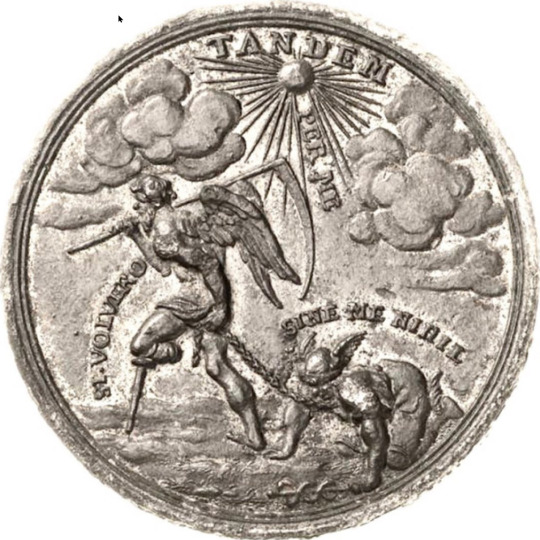
An 18th-century alchemical medallion, possibly a talisman!
The first image is the front with a monogram consisting of the symbols for Sulphur, Salt and Mercury. I like the imaginative way the solar circle and horizontal crescent moon of the top of the glyph for Mercury allude to the 2 intertwined snakes on Mercury’s Caduceus. Above these 3 Paraclesian principles of matter stands the Sun, Philosophical Gold.
The phrase “Trinum in Uno” (Three in One) reminds us that the 3 principles manifest perfectly in the Philosophers’ Stone (which transmutes base metals into gold). This message is reinforced by the triangle within the flames, which of course relate to the Sun, but also to Alchemy itself, which is sometimes called the Art of Fire.
The alchemical symbolism continues on the other side of the medallion, but in a figurative way, with a composite of Saturn/Kronos, with his scythe, wooden leg, and large wings leading a surprisingly non-volatile Mercury, on his hands and knees bound to Saturn by a chain.
In the heavens above we see the sun shining down on the scene with the words “Tandem” (at last), “Per Me” (through me). Mercury’s message is “Sine Me Nihil” (without me nothing), which is actually a quote from John 15:5, where Jesus says “I am the vine: you the branches: he that abideth in me, and I in him, the same beareth much fruit: for without me you can do nothing.” Saturn says “Si Voluero” (if I wished) or perhaps “Si Volvero” (if I should be changed?).
Mercury on the ground certainly suggests that he has been “fixed”, a necessary stage in creating the Stone. Apparently there are words around the edge: “Dum & Cornua Assumit Soror Fit Pater Fratris Sui” (and while the sister takes the horns she is made the father of her brother). This must relate to the sign for gender-fluid Mercury which contains the horned crescent moon. From previous posts you will know that Mercury is the substance that unites the Sun and Moon, sometimes represented as brother and sister, Apollo and Diana.
18 notes
·
View notes
Text
Alchemy 101 - Numbers 1-3
In honor of reaching 1444 followers, I thought I would do a review post of basic alchemy principles.
As a guide, here are a couple of alchemy emblems that lay it out in diagram form.

Heinrich Khunrath, Amphitheatrum sapientiae aeternae, 1602

Michael Maier, Atalanta fugiens, 1618
One
The goal of the alchemical process is to create the Philosopher’s Stone by reconciling and joining opposites into a perfect oneness, symbolized by a circle.
In a story, the hero or heroine is the Philosopher’s-Stone-to-be. So he or she can become “the One” (Maria in A Little White Horse) or “the Chosen One” (Harry Potter). The idea of the chosen one also fits nicely into the paradigm of the Hero’s Journey.
A quite different tack is when an author makes “the One” an inanimate object, such as “the One Ring to rule them all” in Lord of the Rings. In this case the One Ring is pure evil, the complete opposite of what the Stone is meant to be, and it must be destroyed for peace and harmony to be restored.
Two
According to the French alchemist Nicolas Flamel (1330-1418), “all metals have been formed out of sulphur and quicksilver [mercury], which are the seeds of all metals, the one representing the male, and the other the female principle.” (Lyndy Abraham, p. 193). This is the dua prima principle--i.e., there are two basic substances. You can see this clearly in the Michael Maier diagram above--the man and woman are together in the center.
The Male Principle corresponds to Sun, Sulphur, fire and air, hot and dry, fixed, power, Red, gold.
The Female Principle corresponds to Moon, Mercury, earth and water, cool and moist, volatile, wisdom, White, silver.
Almost every alchemy story has a protagonist and an opposite-sex alchemical partner: Maria and Robin, Harry and Hermione, Lyra and Will (His Dark Materials), Meg and Calvin (Wrinkle in Time), Jaime and Brienne (ASOIAF), Sophie and Josh (Secrets of the Immortal Nicholas Flamel). Boy-girl twins, like Sophie and Josh, are a popular choice, especially in stories for younger readers where there’s no romance.
Exception: Tolkien’s main duo are both male, Frodo and Sam. Tolkien worked around the male/female requirement by giving Samwise Gangee a couple of female markers, the “wise” in his name and his occupation as a gardener, a tiller of the earth. (I explained this in an earlier post.)
The Male Principle and the Female Principle unite in a Chemical Wedding, a central process of the Great Work, the opus alchymicum.
Three
The Swiss physician and alchemist Paracelsus (1493-1541) was focused on creating healing medicines rather than making gold. For his purposes, he needed an additional elemental substance--Salt.
According to Paracelsus, all metals were made from a three-fold matter: mercury (the spirit), sulphur (the soul) and salt (the body).... (Abraham, p. 176.)
This is known as the theory of tria prima, i.e., three principles.
On the Khunrath diagram above, the three sides of the triangle are labeled as anima, spiritus, and corpus (soul, spirit, and body).
I’ve yet to encounter a character marked as salt, but there are quite a few examples of trios in alchemy stories where the sidekick to the main duo is marked as body. Body characters typically have a voracious appetite for food and drink and other bodily needs; they are often cowardly. Think Wiggins in The Little White Horse, Ron Weasley, or Papageno in The Magic Flute, the cowardly lion in the Wizard of Oz. In Madeleine l’Engle’s A Wind in the Door, Charles Wallace is literally the body that Meg and Calvin, miniaturized, travel inside to cure his illness.
Please add in the comments examples you know from other alchemy stories. I’m sure I’ve only scratched the surface here. Thanks!
#alchemy#nicolas flamel#paracelsus#chemical wedding#harry potter#lord of the rings#the little white horse#a wrinkle in time#asoiaf#dua prima#tria prima#a wind in the door
79 notes
·
View notes
Text
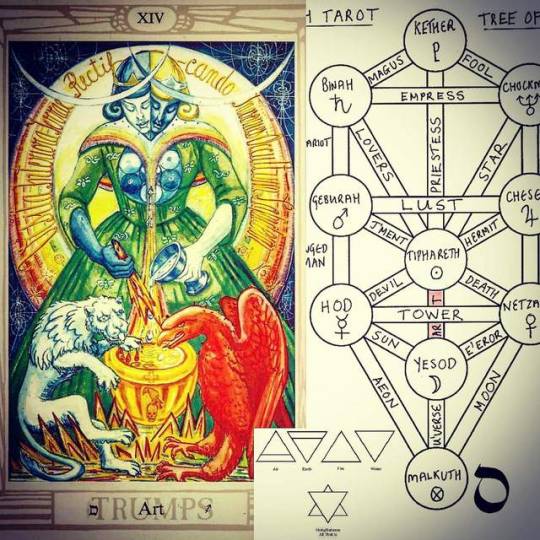
Do what thou wilt shall be the whole of the Law.
March 27th, day seven of our pathworking, meditations, studies and readings lends it keen sting to Atu XIV - 'Art', corresponding to the path Samekh which connects the sephira Yesod and Tiphareth, and Chapter VII of Liber ARARITA.
The Thoth Tarot Atu 'Art' connects path number 25 between Tiphareth (Sun) and Yesod (Moon). Tiphareth is about manifesting beauty in the world and connecting with our centre. Art connects this Sephiroth with Yesod which is a reflection of the subconscious which like dreams can throw up difficult aspects and things we have not yet resolved.
This card is all about integrating these two aspects and bringing the things we have not resolved to the surface and purifying them in our higher self. This can sometimes be a challenging process but it enables us to temper out nature and find balance or the ‘middle way’.
The tarot card 'Temperance' was renamed ‘Art’ by Aleister Crowley to represent the Art of alchemy, although both cards represent the same theme. The figure in Art is called an androgyne: it has both masculine and feminine characteristics and Crowley relates it to the Roman Goddess Diana.The Hebrew attribution for the Temperance card is the letter Samekh, meaning prop or crutch. When we give up our material props and put our faith in our spiritual path our life will be enriched. When we face our fears dwelling in our subconscious we unravel the difficult aspects of our nature that are unresolved and we throw away the prop of being comfortable in where we are, and move to a place of inner beauty, working through these energies that have stagnated beneath the surface of our consciousness.
Art is the opposite of the Lovers Card in the zodiac. They represent forms of the alchemical marriage. In the Lovers we had SOLVE or the act of dissolving and in Art we have COAGULA (same as to coagulate or put together/reassemble). The Lovers reflects the pain of separation whilst Art is about reintegration and harmony.
When you separate a substance and refine it and then put it back together it is something new and improved. This is an analogy for illustrating the process of the spiritual seeker purifying and integrating himself so that he is more spiritually evolved and is a better conduit for the flow of spirit into matter.
The rainbow in background arising from the breastplate and contains the words:
"VISITA RECTIFICANDO INVENIES OCCULTUM LAPIDEM" - visit the interior parts of the earth ; by rectification(purification) thou shalt find the hidden stone. Crowley goes into great detail about this in his Book of Thoth on page 104.
This statement describes the process and result of what has happened in the cauldron. When we go within ourselves (the centre) and purify that which we find, we find the hidden stone(philosophers stone), Enlightenment. We then have colour and harmony surrounding us (rainbow).
VITRIOL = derived from the letters from the above statement. representing the balance of the 3 alchemical principles, sulphur, mercury and salt, or the 3 gunas. Again we have this idea of balance, harmony and integration expressed. The arrow of Sagittarius implies the importance of directed Will.
Liber DCCCXIII vel ARARITA sub figûra DLXX
VII
0. Then in the might of the Lion did I formulate unto myself that holy and formless fire, קדש, which darteth and flasheth through the depths of the Universe.
1. At the touch of the Fire Qadosh the earth melted into a liquor clear as water.
2. At the touch of the Fire Qadosh the water smoked into a lucid air.
3. At the touch of the Fire Qadosh the air ignited, and became Fire.
4. At the touch of the Fire Qadosh, O Lord, the Fire dissipated into Space.
5. At the touch of the Fire Qadosh, O Lord, the Space resolved itself into a Profundity of Mind.
6. At the touch of the Fire Qadosh the Mind of the Father was broken up into the brilliance of our Lord the Sun.
7. At the touch of the Fire Qadosh the Brilliance of our Lord was absorbed in the Naught of our Lady of the Body of the Milk of the Stars.
8. Then only was the Fire Qadosh extinguished, when the Enterer was driven back from the threshold,
9. And the Lord of Silence was established upon the Lotus flower.
10. Then was accomplished all that which was to be accomplished.
11. And All and One and Naught were slain in the slaying of the Warrior 418,
12. In the slaying of the subtlety that expanded all these things into the Twelve Rays of the Crown,
13. That returned unto One, and beyond One, even unto the vision of the Fool in his folly that chanted the word Ararita, and beyond the Word and the Fool; yea, beyond the Word and the Fool.
I hope you all enjoy and benefit from your workings this day!
Love is the law, love under Will.
#thelema#thelemic#thelemite#the british order of thelema#thelemic high holy season#high holy season#holy season#ararita#March 27th 2019#art#samekh#the tree of life#tree of life#kabbalah#qabalah#pathworking#path#meditation#thothtarot#thoth deck#tarot#temperance#occultist#occultism#occult#aleister crowley#ceremonial magick#crowley#ritual magick#magick
10 notes
·
View notes
Photo
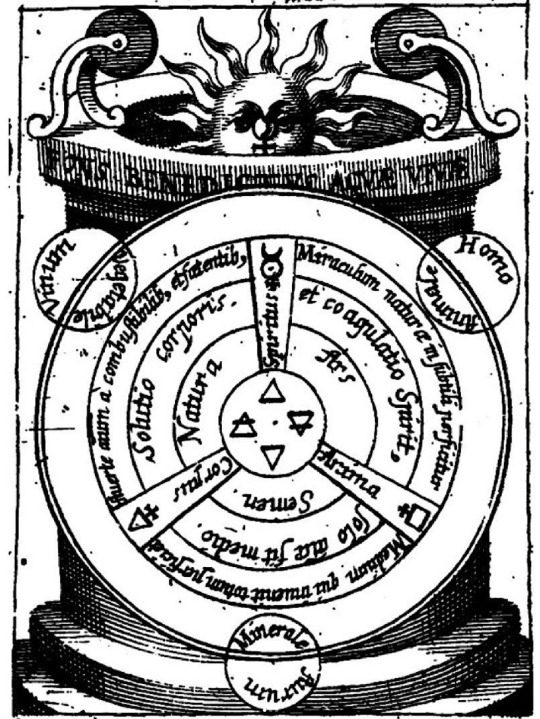
From Basil Valentine’s Philosophical-Chymical Treatise (1676).
The sun at the top, with its eyebrows, nose and mouth as the sign for Mercury. The rim of the well bears the words “Fons Benedictus Aquae Vitae” (Blessed Spring of the Water of Life), alluding to Mercury as the source, primal matter, similar to the Fountain image in the Rose-Garden of the Philosophers.
The large circle with concentric rings contain the signs for the four elements at its center: Fire (top), Water (bottom), Air (left) and Earth (right). The inner ring has the words Ars (alchemy), Natura (nature) and Semen (by some understood as Mercury, the ‘seed’ of the Stone, by others as the Fire that purifies Mercury).
In the next ring we read “Solutio Corporis et coagulatio spiritus solo animae fit medio” (Solution of the Body and Coagulation of the Spirit is done by means of the Soul). This refers to one of the most famous sayings in alchemy, “Solve et Coagula” (Dissolve and Coagulate).
The next ring says “Miraculum naturae in subtili perficitur” (The miracle of Nature is perfected in the subtle), “Medium qui invenit totum perficiet” (He who finds the medium will perfect the whole), and “stuerte animum a combustibilibus, et faetentibus” ([separate]? soul from flammable and stinking things).
At the circumference are 3 small circles representing the 3 kingdoms of nature and how they relate to alchemy. At the bottom: Mineral kingdom and Gold; on the left: Vegetables and Wine (distillation); and on the right: Animals and Man. Finally, intersecting these rings are the three Paraclesian principles of matter: Mercury (top/spirit), Sulphur (left) and Salt (right). The sign for Salt is specifical that for “Tartar”, a salt found on wine barrels, used in medicine as a purgative.
9 notes
·
View notes
Photo

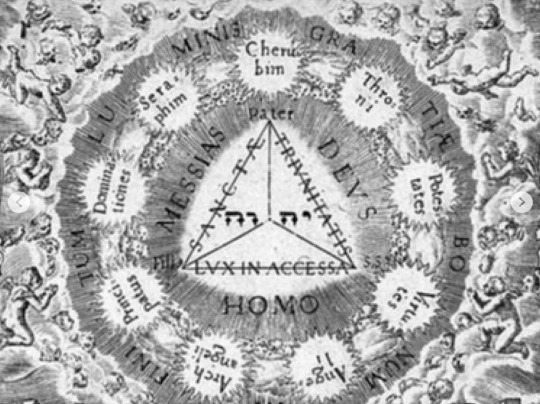
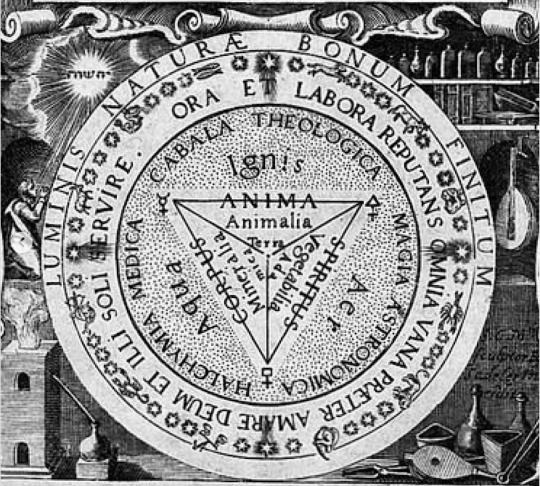

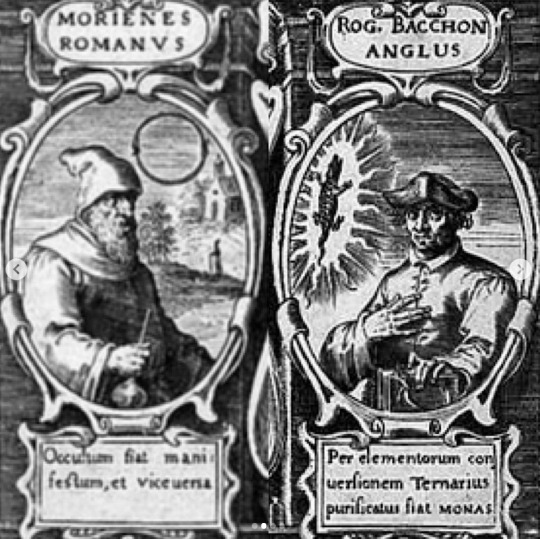
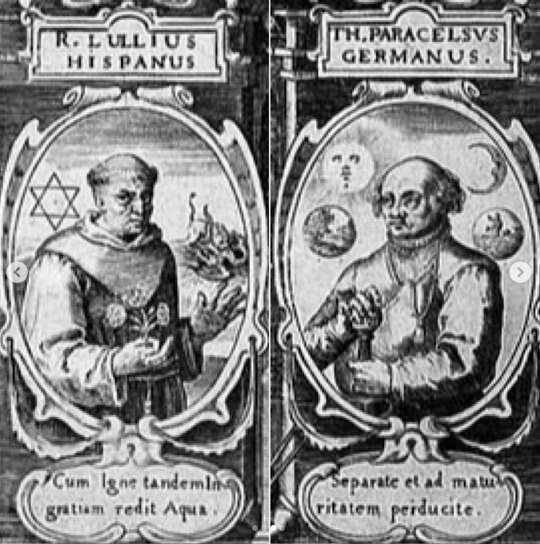
This is the title page of Oswald Croll’s Basilica Chymica (Chemical Basilica, 1608/9). It was an influential work in the spread of Paracelsian philosophy, medicine and alchemy.
Here we see six important alchemical authors, from the Egyptian Hermes Trismegistus, author of the famous Emerald Tablet, to Paracelsus himself. In his hands, Hermes is holding a tablet with the most memorable words ‘What is Above is what is Below’. This message is reinforced by the images above and below the Basilica Chymica’s title: above we see an upwards-pointing (fiery) triangle representing the Holy Trinity, surrounded by 9 orders of heavenly angels (Seraphim, Cherubim, etc.) while below we see a circle, again with a triangle at its center, this time (watery) pointing downwards, representing Body, Spirit and Soul of all things created (animals, vegetables, and minerals).
While the upper triangle has the divine Hebrew name יהוה (YHVH) at its center, this lower triangle has the words ‘Terra Adamica,’ the red earth from which God formed Adam. The names of the other three elements, Fire, Air and Water surround the triangle, with the three Paracelsian principles of matter, Mercury, Sulphur, and Salt at the points of the triangle. Encircling this central image are the names of the three main practices promoted by Croll and other Paracelsians, like Heinrich Khunrath: ‘Theological Cabala’, ‘Astronomical Magic’, and ‘Alchymical Medicine’; actually, Alchemy is described as ‘Halchymical,’ playing on the Greek word for Salt ἅλς (hals), emphasizing the importance of salt in Paracelsian medicine.
Near the circumference of the circle we find the signs of the Zodiac, connected with the Astronomical Magic. On the left we see an alchemical furnace (athanor) and glass receiver, while the alchemist prays for success in the background, the Christian Cabalist name for Jesus יהשוה (YHSVH) overhead. On the right we see alchemical equipment at ground level (bellows, tongs, crucibles, glass vessels), with shelves above bearing jars and bottles of laboratory substances, books of theory and practice, and a lute hangs from a hook perhaps to while away the time spent waiting for something to happen in the in the athanor or even to tune in to the harmony of the spheres.
Hermes Trismegistos the Egyptian - often regarded as the inventor of alchemy, holding the Emerald Tablet: ‘Quod est suprerius, est sicut id quod est inferius’ (What is above is like what is below). In the background is the image of a phoenix sitting in flames.
Arabic Geber - author of the most influential medieval book on gold-making, the Summa Perfectionis Magisterii (Sum of the Perfect Magistery), with the words ‘In Sole et Sale naturae sunt omnia’ (All things are in the Sun and Salt of nature). Behind hims another alchemical bird, a Pelican is feeding its young with blood from its own breast.
Morienus the Roman - the first Christian alchemist, who it is said taught the first Muslim alchemist, Khalid ibn Yazid. Below him is the advice ‘Occultum fiat manifestum, et vice versa’ (Let the hidden be revealed, and vice versa). In the background we can see a church, possibly because he was a hermit, and in the air two serpents biting each others’ tails, alchemical symbol for digestion, regeneration, and the union of opposites.
Roger Bacon - a 13th-century monk, one of the first to write about alchemy in England, with a Salamander, believed to be able to live in fire, symbol of the Philosopher’s stone. His words: ‘Per elementorum conversionem Ternarius purificatus fiat MONAS’ (Through the conversion of the elements the purified Triplicity is made the ONE.’
Ramon Lull - a 13th-century Spanish philosopher, missionary and mystic, shown with a hexagram (symbolizing Fire & Water combined), holding 3 roses. In the background what might be a lion killing a swan, with the words ‘Cum igne tandem in gratiam redit aqua’ (With fire at last water returns to grace)
Theophrastus Paracelsus (1493 - 1541) the German, accompanied by the fiery Sun and watery Moon, together with the spheres of air and earth [?] (i.e. the four elements), his hand on the pommel of his sword, bearing the word Azoth, offers us the sage advice ‘Separate et ad maturitatem perducite’ (Separate and bring to fruition).
7 notes
·
View notes